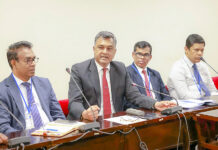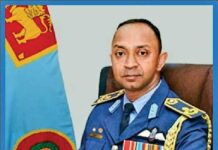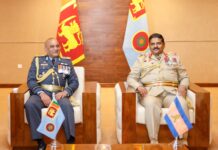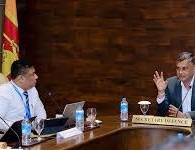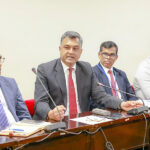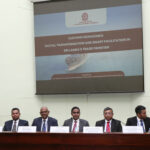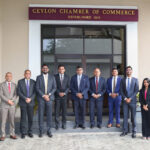By: Nalin Jayetileke
The Sri Lanka Air Force will celebrate its 71st Anniversary today. This year the traditional celebration was held at the Sri Lanka Air Force Base Katunayaka under the leadership of the Commander of the Sri Lanka Air Force, Air Marshal Sudarshana Pathirana .
The Sri Lanka Air Force was formed on the 02nd of March 1951 as the Royal Ceylon Air Force and when Sri Lanka became a republic in 1972 the Royal Ceylon Air Force was re-designated as the Sri Lanka Air Force.
The Air Force which was formed on 2nd March 1951 and was known as the Royal Ceylon Air Force with RAF Officers and other personnel seconded to the RCyAF. Ceylonese were recruited to the new RCyAF and several Ceylonese who had served with the RAF during World WWII were absorbed in the force. Initial objective was to train local pilots and ground crew, early administration and training was carried out exclusively by RAF officers and other personnel on secondment.
The first aircraft of the RCyAF were de Havilland Canada DHC-1 Chipmunks used as basic trainers to train the first batches of pilots locally while several cadets were sent to Royal Air Force College Cranwell. These were followed by Boulto Paul Balliol T.Mk.2s and Air Speed Oxford Mk.1s for advanced training of pilots and aircrew along with de Havilland Doves and de Havilland Herons for transport use, all provided by the British. By 1955 the RCyAF was operating two flying squadrons based at RAF Negombo. The first helicopter type to be added to the service was the Westland Dragonfly.
The Royal Ceylon Air Force first went into combat in 1971 when the Marxist JVP launched an Island -wide insurrection on April 5. The Ceylon Armed Forces were caught off guard; police stations island-wide and the RCyAF base at Ekala were attacked in the initial wave. Responding rapidly the RCyAF deployed its limited aircraft, at first to resupply besieged police stations and military outposts and patrol around major cities. The Jet Provosts were taken out of storage and put into service within three days, carrying out attacks on insurgents. During this insurgency Sri Lanka turned to the Soviet Union for more sophisticated weaponry, and received five Mikoyan – Gurevich MiG 17 F fighter bombers and a MiG -15 trainer, as well as two kamov Ka -26 helicopters meant for search and rescue and casualty evacuation. The RAF’s heavy transports also flew in six Bell 47G helicopters purchased from the United States, which were put into combat as soon as possible after only five days of pilot training. Air Force personnel joined in ground operations, and when the insurgents surrendered after about a month’s fighting the RCyAF was in charge of three of the many rehabilitation camps setup for insurgents.
With Ceylon becoming a republic in 1972, the Royal Ceylon Air Force changed its name to the Sri Lanka Air Force along with all insignia. Because of a shortage of funds for military expenditure in the wake of the 1971 insurrection, the No. 4 Helicopter Squadron began operating commercial transport services for foreign tourists under the name of Helitours On March 31, 1976, the SLAF was awarded the Presidents Colours. That same year SLAF detachments, which later became SLAF stations, were established at Wirawila, Vavuniya and Minneriya.
With the closure of Air Ceylon in 1978, its Hawker Siddeley HS 748 transport aircraft was taken over by the SLAF. By the early 1980s the Provosts and all of the Soviet aircraft had been taken out of active service and placed in long-term storage, leaving the air force without any fighter/bomber capability.
Rapid growth began in the mid-1980s, when the Sri Lankan Civil War against Tamil separatists drew the service into a major, long-term security role. In 1982 the SLAF reactivated airfields at Batticaloa, Anuradhapura , Koggala and Sigiriya that had been disused since World Wat II, all later becoming SLAF Stations. During the First Eelam War between 1983 and 1987, the force grew by nearly 50 percent. In 1987 the air force had a total strength of 3,700 personnel, including active reserves.
From the period 1983 to 1985, the Air Force acquired 11 Bell 212 helicopters, four Bell 412 helicopters, three SIAI Marchatti SF .260 s, two Cessna 337 , one Hawker Siddely HS 748 and two Beechcraft Super King Airs. By 1985, nine more Bell 212s were added to the fleet, along with four Bell 412s. The 412s along with the SIAI Marchetti SF.260 aircraft advanced the attack capabilities of the SLAF.
A more effective bombing capability was provided by a small fleet of Chinese Harbin Y-12 turboprop transport aircraft. These were equipped with bomb racks that had been fitted to carry up to 1,000 kilograms of fragmentation and anti- personnel bombs. Transport, training, and surveying functions were carried out by a variety of Cessna and de Havilland aircraft. In 1987 during the Vadamarachchi Operation the air force mustered one HS 748, two Y-12s and one de Havilland Heron, all configured as improvised bombers. In 1987 the air force acquired Shaanxi Y 8s and would later use them for bombing, until 1992 when one Y-8 crashed during a bombing mission, when all bombing using transport aircraft were stopped.
o increase its attack capability, in 1991 the SLAF acquired four F-7 Shy Bolts , three FT-7s and two Shenyang J-5s from China. Later in 1993 the first of three Mi 17 helicopter transports were acquired along with four FMA IA 58 Pucaras for ground attack. These proved to be effective, but three of the Pucarás were lost, two to surface -to-air missiles launched by the LTTE. The sole remaining Pucará was retired in 1999 due to lack of spare parts. In 1995 Mi 24 gunships were acquired for close air support for the army and by 2001 Mi 35 were added to the fleet.
In 1996 the SLAF acquired seven IAI Kafir (six C.2s and one TC.2) from Israel and a further nine of these aircraft had been added to the inventory by 2005. This included four C.2s and four C.7s in 2001. Currently the SLAF operates two C.7s, eight C.2s and two TC.2s.
Following the end of the civil war the number of sorties flown were reduced. The air force began utilizing its fix wing and rotary wing transport aircraft for civilian transport by reforming the civilian domestic airline Helitours. It also began undertaking international flights and deployments as part of humanitarian and UN peacekeeping UN PEACEKEEING operation.
In 2014, the SLAF deployed a contingent of three Mi-17 helicopters with support personnel and equipment designated No. 62 Helicopter Flight to the United Nations Missions consisting of 122 personal. This was followed by second contingent three Mi-17 helicopters and 81 personal to UN Missions in South Sudan.
In December 2014, SLAF C-130 of the No. 2 Heavy Transport Squadron flew a special humanitarian operation transporting essential spares and accessories for repair of the desalination facility in Male from Singapore. The breakdown of the desalination facility resulted in a desperate shortage of drinking water in Male and the equipment for repair could not be flown in commercial flights, resulting in the Maldivian government requesting aid from the government of Sri Lanka.
In 2021, the SLAF initiated a program for the overhaul and service life extension of several of its aging air frames. This include five Kfirs fighters, two C-130 transports, four Antonov-32 transports, three Mi-17 heavy transport helicopters and its remaining Mi-35 attack helicopters. Two additional Y12 transports are to be purchased as are 4 secondhand Bell 206B3 training helicopters.
in 2020, the SLAF has been in talks to acquire either Dornier Do 228 or Beechcraft 360ER maritime reconnaissance aircraft from India and the United States respectively. In February 2022, the US Government agreed to provide two Beechcraft 360ER on a gratis basis under a foreign military sales contract to enhance the SLAF’s maritime reconnaissance capability.
The SLAF has also embarked on the indigenous Lihiniya UAV program. The Lihiniya 1 had its first flight in April 2020. The SLAF intends to have the first models entering service by the end of 2021 and implement lessons learnt in the design of the Lihiniya II UAV.
During the past 71 years the Air Force has had 18 Commanders with Air Commodore JC Bladen as its first Commander of the then Royal Ceylon Air Force. Air Chief Marshal PH Mendis became the first to command the Sri Lanka Air Fore.
The Sri Lanka Air Force is now commanded by Veteran Kafir jet pilot Air Marshal Sudarshana Pathirana who has over 3,500 flying Hours and decorated with gallantry medals on 8 occasions. Namely, “Weera Wicrama Vibhushana ” twice, ” Rana Wickrama Pdakkama ” twice and ” Rana Sura Padakkama” on four occasions. .
The sundayreader.lk would like yo take this opportunity to convey our best wishes to the Commander, the Board of Directors, all officers, Air men/ Airwomen and Civilian staff of the Sri Lanka Air Force!
Source for compilation of article courtesy and Credit to : https://en.wikipedia.org/, Airforce.lk and other SLAF Source




